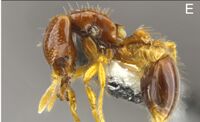Strumigenys oasis
| Strumigenys oasis | |
|---|---|

| |
| Scientific classification | |
| Kingdom: | Animalia |
| Phylum: | Arthropoda |
| Class: | Insecta |
| Order: | Hymenoptera |
| Family: | Formicidae |
| Subfamily: | Myrmicinae |
| Tribe: | Attini |
| Genus: | Strumigenys |
| Species: | S. oasis |
| Binomial name | |
| Strumigenys oasis Sarnat, Hita-Garcia, Dudley, Liu, Fischer & Economo, 2019 | |
Identification
Strumigenys oasis is without doubt the most peculiar representative of the genus in Fiji. The strongly truncated and arcuate mandibles with four spiniform apical teeth are unlike any other Strumigenys in Fiji—and possibly unique across the entire genus. They appear descended from an ancestor with long and linear mandibles rather than one with triangular mandibles armed with denticles. Another feature apparently unique to S. oasis is the circular pit excavated from the middle of the posterior head margin (Fig. 21D). While similar structures are observed in the species of other genera to receive ocelli, this does not appear to be the case for S. oasis. The third most anomalous feature of S. oasis is the dense tuft of white filamentous hairs arising from the lateral promesonotal border above the procoxae. Though homologous invaginations occur in many of the Fijian Strumigenys species, none are so deep or so densely covered in hairs as that of S. oasis. The only Fijian Strumigenys species approaching S. oasis in morphology is Strumigenys basiliska. Both are strongly polished and have short and curved mandibles with spiniform teeth, but those of P. basiliska are distinctly longer than those of S. oasis. Additionally, P. basiliska lacks the median pit on the posterior head margin, shield-shaped head, propodeal lamellae, and abundant long, stiff, erect hairs.
Distribution
Distribution based on Regional Taxon Lists
Indo-Australian Region: Fiji (type locality).
Distribution based on AntMaps
Distribution based on AntWeb specimens
Check data from AntWeb
Countries Occupied
| Number of countries occupied by this species based on AntWiki Regional Taxon Lists. In general, fewer countries occupied indicates a narrower range, while more countries indicates a more widespread species. |

|
Biology
The only collection of this species is from a leaf litter sample taken at Nabukavesi in southeastern Viti Levu.
Castes
 X-ray micro-CT scan 3D model of Strumigenys oasis (worker) prepared by the Economo lab at OIST.
X-ray micro-CT scan 3D model of Strumigenys oasis (worker) prepared by the Economo lab at OIST.
Strumigenys FJ19. See on Sketchfab. See list of 3D images.
Nomenclature
The following information is derived from Barry Bolton's Online Catalogue of the Ants of the World.
- oasis. Strumigenys oasis Sarnat, Hita-Garcia, Dudley, Liu, Fischer & Economo, 2019: 38, figs. 8C, 8D, 10E, 10F, 21, 27, Model 5 (w.) FIJI.
Description
Measurements (n = 2): TL 2.38–2.42 mm, HL 0.68–0.72 mm, HW 0.57–0.60 mm, CI 83–84, MdL 0.11 mm, MI 16, SL 0.31–0.35 mm, SI 44–45, PW 0.33 mm, PI 55–58, FL 0.31–0.35 mm, FI 52–61, EL 0.33 mm. Color polished reddish brown with yellow appendages. Head cordate, shield-like, becoming very broad posteriorly. Median of posterior head margin with distinct and deeply excavated circular pit. Mandibles strongly truncated and arcuate; shorter than length of terminal antennal segment. Apical fork comprised of three teeth; apical-most two teeth half the length as the third. In addition to the aforementioned three teeth is the basal-most fourth tooth, equal in length to the third, that is apparently homologous to the preapical tooth of relative species but here located so far distally as to be contiguous with the apical fork. Apicoscrobal hair thing stiff and straight. Ground pilosity of cephalic dorsum composed of short and appressed weakly spatulate hairs. Clypeal shield distinct and covered by closely spaced appressed spatulate hairs. Antennal scapes proportionately short (SI 44–45). Pronotal humeral hairs long, straight, and stiff. Surface of entire body strongly polished, entirely lacking sculpture except for short basigastral costulae. Dense tuft of white filamentous hairs arising from the lateral promesonotal border above the procoxae. Dorsal surfaces of mesosoma and metasoma with abundant long, stiff, erect hairs. Legs with abundant hairs similar to those on dorsal surfaces of body but entirely lacking flagellate hairs. Propodeal tooth short, broadly triangular. Propodeal lamella in profile with strongly convex posterior margin. In dorsal view, petiolar node distinctly broader than long. Ventral lobe of postpetiole large and broad, more lamellate than spongiform. Posterodorsal lobe of postpetiole obliquely costate, similar in pattern to basigastral sculpture.
References
- Liu, C., Sarnat, E.M., Friedman, N.R., Hita Garcia, F., Darwell, C., Booher, D., Kubota, Y., Mikheyev, A.S., Economo, E.P. 2020. Colonize, radiate, decline: Unraveling the dynamics of island community assembly with Fijian trap‐jaw ants. Evolution 74, 1082–1097 (doi:10.1111/EVO.13983).
- Sarnat, E.M., Hita-Garcia, F., Dudley, K., Liu, C., Fischer, G., Economo, E.P. 2019. Ready species one: Exploring the use of augmented reality to enhance systematic biology with a revision of Fijian Strumigenys (Hymenoptera: Formicidae). Insect Systematics and Diversity 3(6): 6; 1–43 (doi:10.1093/isd/ixz005).

